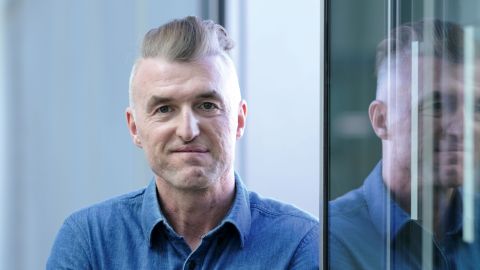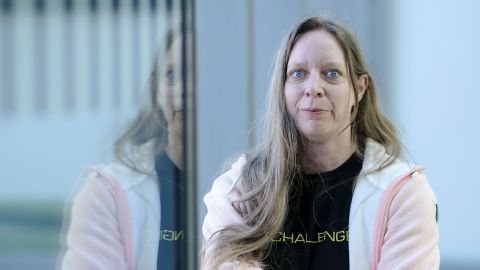I've noticed for a long time that I'm good at remembering faces," says Nathalie Broschinski. "When I watch films on TV, I also recognize supporting actors that I've seen in other small roles. My friends always look at me in disbelief." Together with David Paprocki and Samanta Kliner, the detective superintendent belongs to the rare species of super-recognizers (SR). All three have high hopes for the country's new SR project. "It's good that things are really taking off now," they say.
Although biometric facial recognition is constantly being optimized, people with special talents apparently still work better than computer image matching programs in some areas. This is particularly true when images are blurred or the people depicted are largely obscured, for example by masks.
Scientists believe that less than two percent of the population have the abilities of super-recognizers. They are able to memorize faces and other details with above-average accuracy. Even if the expression has changed significantly due to ageing, hairstyle, beard or weight. This has been documented in tests.
In 2011, the London police, in cooperation with the University of Greenwich, developed a procedure to identify such special talents. They were used in the investigation into the "London Riots" and were very successful in solving the violent riots that spread across several British cities.
At the time, 1,300 of the 4,000 charges were based on the use of super-recognizers. Germany began to take an interest in these very special "brains" after New Year's Eve in Cologne in 2015/16. At that time, super-recognizers from England supported German investigators in order to convict perpetrators.
On 14 November 2018, Dortmund Police Headquarters was the first police authority in North Rhine-Westphalia to set up a project group on this topic. The authority in Cologne followed suit a little later. Nathalie Broschinski, who was still working in Cologne at the time, took the test in 2020 following a call on the intranet. She achieved the required high score, which now identifies her as a super-recognizer.
She is now a clerk at the LKA in the Central Evaluation Office. At the BAO Berg, which had to solve an incredibly high number of child abuse cases, her intuition helped to identify victims. "When I recognize someone, it clicks," she says. It's difficult to explain. "It just comes from the gut."
Criminal Superintendent David Paprocki from KK14 in Dortmund also passed the SR test with flying colors. In his day-to-day work, he mainly deals with pickpocketing. "I can identify a person from their movements in the surveillance camera footage and then often find them again in different footage at different locations," he explains. "That's how we know we're dealing with a serial offender."
When the 43-year-old was involved in the "EK Drive-in", his talent came into play again.
He studied the available images and video footage of ATMs that had been spread open and emptied and repeatedly spotted a guy with cropped hair and a slinking gait.
In court, he suddenly appeared with long hair, so the judge initially didn't recognize him from the film sequences. "However, the public prosecutor's office was able to make it clear that the defendant was identical to the person on the footage based on our information," reports the criminal investigator. The ATM burglar was convicted.
David Paprocki once discovered that he had special antennae on a school trip. At the time, he noticed someone in a youth hostel who was behaving differently to the others. "Suddenly a sweater had disappeared and I was able to describe the boy who had seemed strange to me." The missing item of clothing was then found on him, he says.
Samanta Kliner is the third member of the Super Checkers. She has known since early childhood that she ticks a little differently to the others. The autistic woman has been working as a government employee at the North Rhine-Westphalian State Criminal Police Office since 2020. The higher police authority had advertised for someone with special perceptive abilities.
"I don't have the noise filter that makes you separate the important from the unimportant," she says. "But that also has advantages. When I'm researching, I'm like I'm in a tunnel and catch even the smallest details that usually fall through the cracks."
At the LKA, Samanta Kliner works in the central evaluation and collection point for child pornography and has often been able to make the connection to other cases by uncovering small details (such as the cut-out of a carpet pattern, the corner of a lampshade, an unusually shaped thumb, the position of an arm).
"I'm there to organize and bundle the material," explains the 42-year-old modestly. Before joining the police, she set up a support organization for autistic people. She soaks up all the information like a sponge, she says matter-of-factly. "How someone walks, how a shoe stands on a shelf, how individual voices sound and differ." Every day, she copes with a flood of images, which are then "laboriously" translated into speech.
Autistic people are still the big exception in German police forces. A number of police officers are already listed as super-recognizers in NRW.
A spectacular result from Dortmund shows just how useful super-recognizers can be in surveillance and search measures. At a Borussia soccer match, a Super Recognizer identified a suspect among 20,000 spectators in the Signal Iduna Park after just a few minutes. Prior to this, an officer familiar with the scene had spent a long time searching for the wanted man with the camera, to no avail.
Other federal states are also experimenting. In some cases, super-recognizers have already been placed in city centres to filter out faces that they had previously only seen for fractions of a second. And the memory professionals have indeed found what they were looking for.
The North Rhine-Westphalian Ministry of the Interior wants to find out more and coordinate and standardize the approaches taken so far. The NRW State Office for Training, Further Education and Personnel Affairs (LAFP) has developed a concept that has now been approved by decree. The district police authorities of Dortmund, Düsseldorf, Essen, Cologne, Bochum and Siegen-Wittgenstein are to provide information on selection criteria and possible applications for super-recognizers in a pilot test.
Superintendent Jörg Weßels from the LAFP believes that super-recognizers can bring considerable added value. "We are adopting the computer-aided sequential testing procedure of the Berlin police free of charge in order to recruit suitable police officers for our project," he announces. Selection and practical implementation would take at least ten months. "After that, we will draw our conclusions."
The LAFP points out that the sighting and recognition of a suspicious person by a super-recognizer constitutes witness evidence and can be a starting point for new investigations. While biometric recognition procedures in public spaces are subject to strict requirements, there are no legal objections to the use of super-recognizers.
All police officers in the selected district police authorities can apply. According to the LAFP, those who qualify will initially carry out the upcoming tasks as super-recognizers on a part-time basis. This could be with the CID or in the security service, but also in the area of traffic.
"The reports will then be available next year," explains Criminal Superintendent Weßels, who is jointly responsible for personnel selection at the LAFP as head of the sub-department. "By then, we hope to have gained reliable insights into the selection process and the possible uses of super-recognizers."


